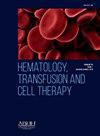5+2化疗和达沙替尼后高细胞计数加速期CML逆转:1例报告
IF 1.6
Q3 HEMATOLOGY
引用次数: 0
摘要
慢性髓系白血病(CML)通常经历慢性、加速和母细胞期,大多数患者在慢性期对酪氨酸激酶抑制剂(TKIs)反应良好。然而,加速期(AP) CML患者如果出现高细胞计数和TKI耐药性,通常被认为有转变为blast - phase (BP) CML或继发性AML的风险,需要强化化疗或干细胞移植。该病例强调了AP-CML患者在接受5+2化疗和达沙替尼后实现了完全的血液学和分子缓解,尽管在治疗开始前具有高细胞计数和延长的无tki期。一名44岁男性被诊断为CML(2022年2月),由于持续BCR-ABL阳性和极端血小板增多,最初使用伊马替尼治疗,随后使用达沙替尼、博舒替尼和尼洛替尼治疗(>;100万/µL)。到2024年10月,由于BCR-ABL水平上升至85%,骨髓活检显示17%的原细胞,怀疑疾病转化。值得注意的是,患者在住院前至少三个月停止使用达沙替尼,进一步促进了疾病进展。鉴于高细胞计数和持续的血小板增多,给予5+2诱导化疗(阿糖胞苷 + 伊达柔比星),随后于2024年12月进行骨髓活检重新评估,结果尚无定论。化疗后,患者拒绝进一步aml定向治疗,转而恢复达沙替尼治疗。在接下来的6个月里,患者的血液学参数正常化,重复骨髓活检证实完全缓解,显示出加速期的显著逆转。结论本病例表明,在5+2化疗和重新启动TKI治疗后,高细胞计数的AP-CML有可能恢复到慢性期。该研究还强调了晚期CML患者停用TKI的风险,并提示TKI靶向治疗即使在短暂化疗诱导的细胞减少后仍可保持有效。这突出了个体化治疗方法在晚期CML中的重要性,以及在特定病例中避免aml定向治疗的潜力。本文章由计算机程序翻译,如有差异,请以英文原文为准。
REVERSAL OF ACCELERATED PHASE CML WITH HIGH BLAST COUNT FOLLOWING 5+2 CHEMOTHERAPY AND DASATINIB: A CASE REPORT
Introduction
Chronic Myeloid Leukemia (CML) typically progresses through chronic, accelerated, and blast phases, with most patients responding well to Tyrosine Kinase Inhibitors (TKIs) in the chronic phase. However, patients with Accelerated-Phase (AP) CML who develop high blast counts and TKI resistance are often considered at risk for transformation into Blast-Phase (BP) CML or secondary AML, requiring intensive chemotherapy or stem cell transplantation. This case highlights a patient with AP-CML who achieved full hematologic and molecular remission after receiving 5+2 chemotherapy and dasatinib, despite a high blast count and a prolonged TKI-free period before treatment initiation.
Case presentation
A 44-year-old male was diagnosed with CML (February 2022) and initially treated with imatinib, followed by dasatinib, bosutinib, and nilotinib due to persistent BCR-ABL positivity and extreme thrombocytosis (> 1 million/µL). By October 2024, disease transformation was suspected due to BCR-ABL levels rising to 85% and bone marrow biopsy showing 17% blasts. Notably, the patient had discontinued dasatinib at least three months before hospitalization, further contributing to disease progression. Given the high blast count and persistent thrombocytosis, 5+2 induction chemotherapy (cytarabine + idarubicin) was administered, followed by a reassessment bone marrow biopsy in December 2024, which was inconclusive. Post-chemotherapy, the patient refused further AML-directed treatment and instead resumed dasatinib therapy. Over the following six months, the patient’s hematologic parameters normalized, and repeat bone marrow biopsy confirmed complete remission, demonstrating a remarkable reversal from the accelerated phase.
Conclusion
This case illustrates the potential for AP-CML with a high blast count to revert to the chronic phase following 5+2 chemotherapy and re-initiation of TKI therapy. It also underscores the risks associated with TKI discontinuation in advanced CML and suggests that targeted therapy with TKIs can remain effective even after transient chemotherapy-induced cytoreduction. This highlights the importance of individualized treatment approaches in advanced CML and the potential for avoiding AML-directed therapies in select cases.
求助全文
通过发布文献求助,成功后即可免费获取论文全文。
去求助
来源期刊

Hematology, Transfusion and Cell Therapy
Multiple-
CiteScore
2.40
自引率
4.80%
发文量
1419
审稿时长
30 weeks
 求助内容:
求助内容: 应助结果提醒方式:
应助结果提醒方式:


